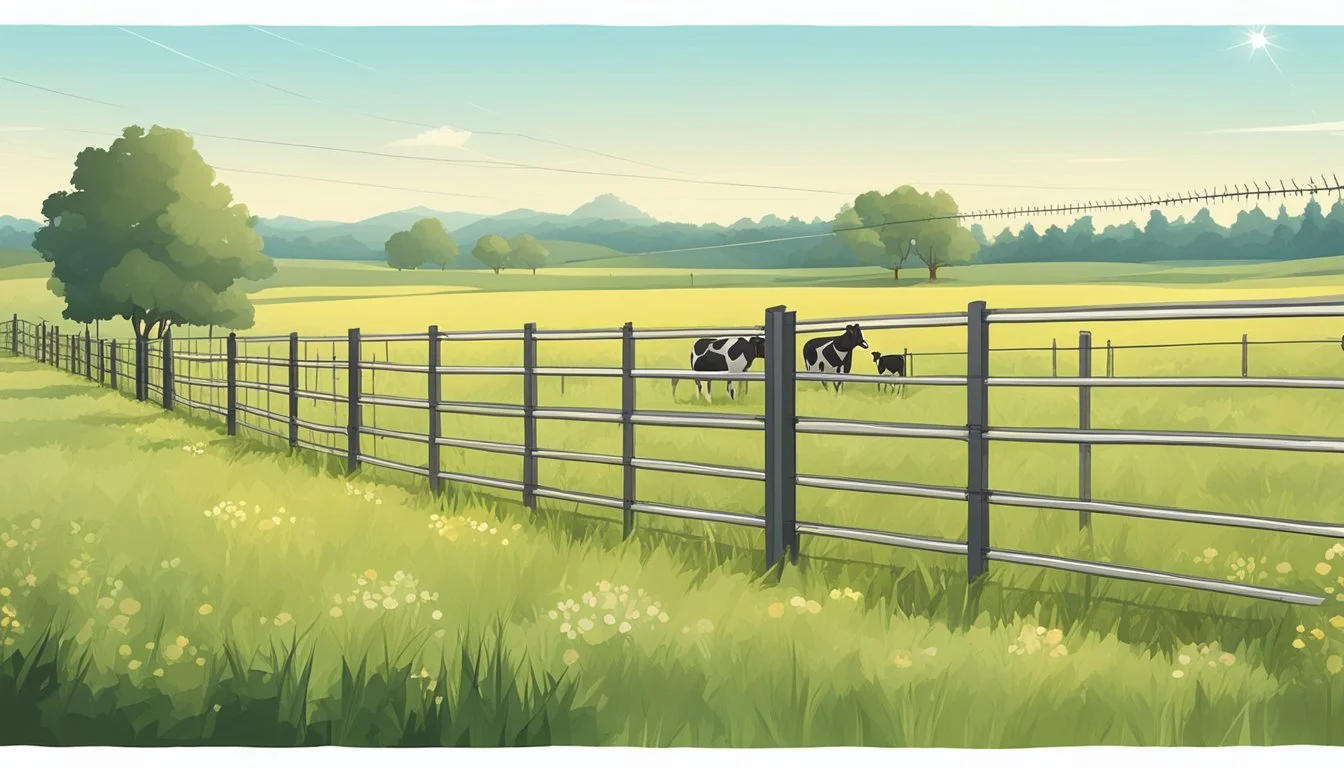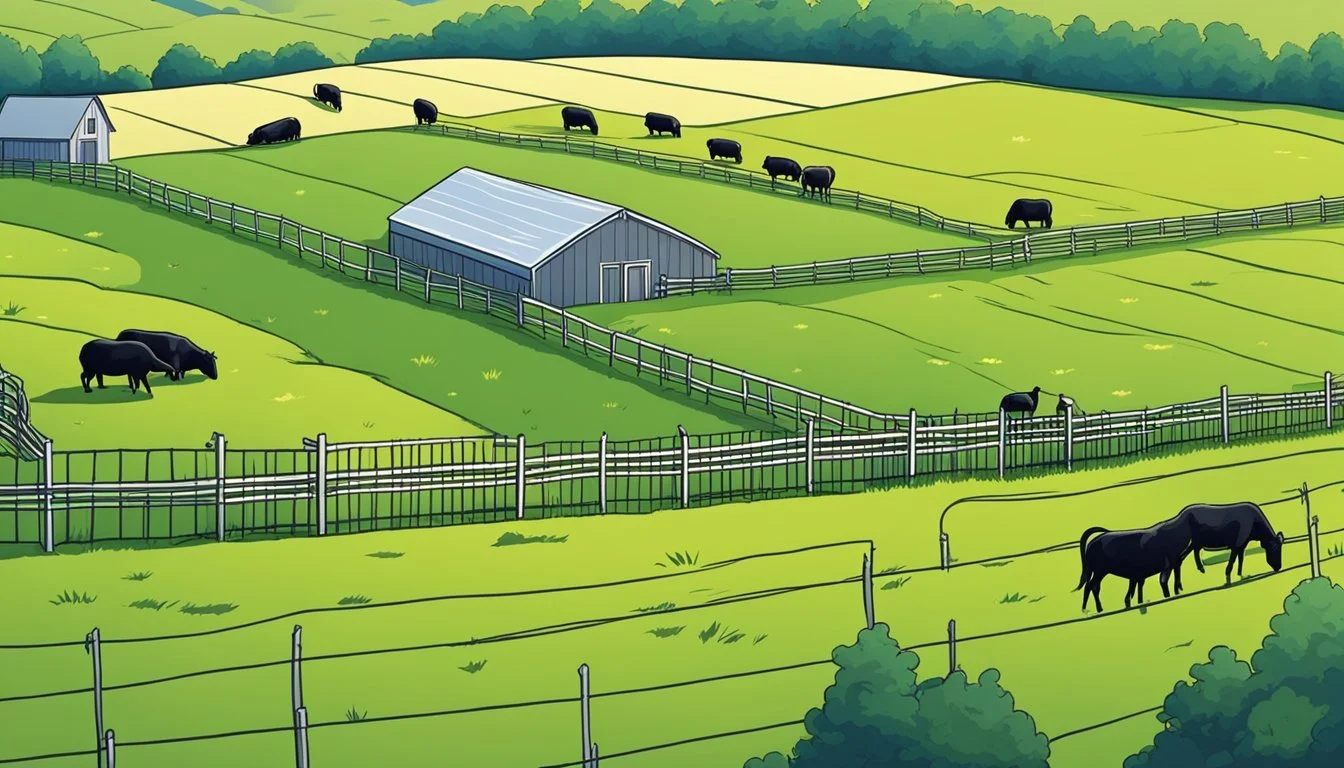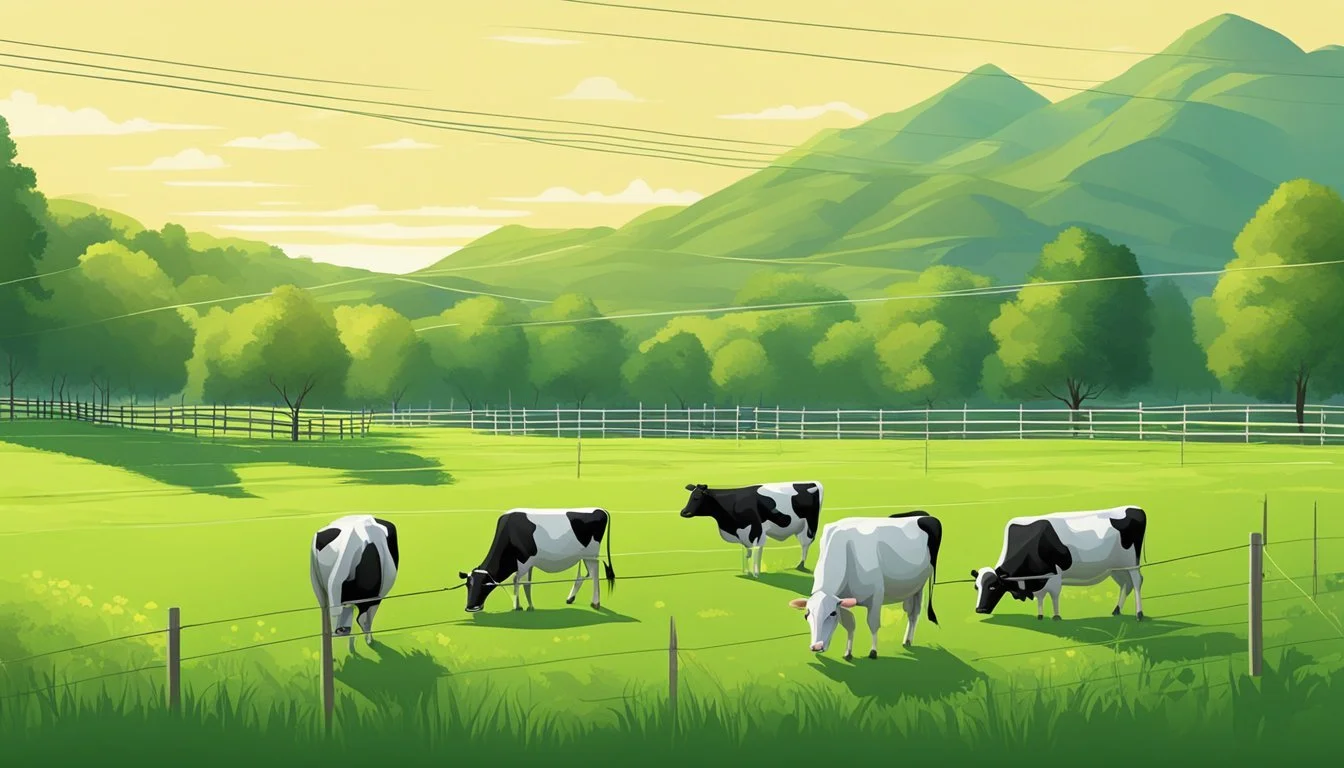The Ultimate Guide to Using Electric Fencing Polytape for Livestock Barriers
Essential Tips for Safe and Effective Enclosures
Electric fencing is a popular solution for containing and managing livestock, providing both a psychological and a physical barrier to animal movement. Polytape, a variant of electric fencing, combines strands of metal wire interwoven with polyethylene tape, resulting in a highly visible and effective fencing option. Its width and design allow livestock to easily see the fence, thereby reducing the chance of animals running into it, which is particularly beneficial for horses and other flighty animals.
The use of polytape in electric fencing offers flexibility and ease of installation. As a fencing material, it's lightweight and easily adjusted, making it a suitable choice for temporary setups or rotational grazing systems. Electric fences equipped with polytape can deter livestock from challenging the barrier by providing a harmless but memorable shock, reinforcing the psychological barrier without causing injury.
To create an effective livestock barrier with polytape, it is essential to understand the appropriate applications and installation techniques. This includes selecting the right thickness of polytape based on the type and size of the pasture, as well as proper tensioning and grounding for maximum efficacy. With the correct setup, polytape electric fences serve as a reliable deterrent to keep animals within designated areas, while also allowing for the flexibility needed in modern herd management.
Benefits of Using Electric Fencing Polytape
Electric fencing polytape offers a highly effective solution for creating livestock barriers. It stands out in terms of enhanced visibility, ease of maintenance, and long-term durability.
Visibility and Animal Safety
Polytape is significantly more visible compared to traditional wire. Its broad, ribbon-like form is especially beneficial for larger animals like horses, which can easily see the fencing. Safety is improved as animals are less likely to run into or through the fence, reducing injury risks.
Ease of Installation and Versatility
The installation process of polytape electric fences is straightforward. It can be handled by a single individual without sophisticated tools. Polytape is versatile and can be set up using a variety of post types and configurations. With options from 1-inch to 2-inch widths and systems that accommodate up to 5 strands, farmers can tailor the fences to their specific needs.
Durability and Longevity
Despite being easy to handle, polytape is designed to withstand wear and tear. The woven polyethylene and metal threads ensure a balance between flexibility and strength, contributing to its longevity. The life expectancy of electric fencing polytape is impressive, maintaining effectiveness and durability over time.
Planning Your Electric Fence Layout
Proper planning of an electric fence layout is essential for ensuring effective livestock containment and management, alongside property protection. The layout should be mapped meticulously, materials selected based on animal and boundary requirements, and considerations for various livestock types must be taken into account.
Mapping Out the Perimeter
To begin, measure the boundary of the area using a measuring tape to ascertain the exact perimeter. Sketch the property layout, including where to place fence posts and the location of any additional structures that will interact with the fence line. For those practicing rotational grazing, include multiple paddocks within the plan to facilitate grazing management.
Selecting the Correct Materials
Choosing the right materials is critical for both the efficacy and longevity of the fence. Poly tape is highly visible, making it an excellent choice for horses and other livestock. Ensure adequate insulators are selected to prevent energy loss, and use durable T-posts or steel posts for stability. Incorporate the right connectors, tensioners, and a suitable energizer to maintain consistent voltage levels.
Considering Livestock Types
Different animals have different fencing needs. Horses typically respond well to visual barriers like poly tape, while cows and cattle may require stronger materials. Goats and sheep need closer post spacing to prevent escape, whereas pigs and bulls may require a lower line of tape to keep them contained. Always plan the fence layout with the specific behaviors and containment requirements of the intended livestock in mind.
Installing the Electric Fencing Polytape
Proper installation of electric fencing polytape is vital for creating an effective livestock barrier. Careful attention to securing posts, stretching the tape correctly, and connecting the power source ensures the fence will function as intended.
Setting Up Posts and Insulators
The initial step in installing electric fencing polytape is setting up sturdy posts at measured intervals along the intended fence line. Corner posts must be well-anchored as they bear the brunt of the tension from the polytape. T-posts or wooden posts are commonly used, and their spacing can vary depending on the terrain and size of the area being fenced.
Once posts are in place, insulators must be attached at the appropriate height to prevent the polytape from touching the posts and ensuring that the shock from the fence is not grounded out. Insulators suitable for polytape must be chosen as they are specifically designed to hold the tape flat and secure.
Mounting the Polytape
After the insulators are installed, the polytape can be mounted. Starting at the corner post, the polytape should be pulled taut to maintain proper tension. Tensioners can be used at corners to assist with this and to allow for easy adjustments. Connectors may be employed at spans where two ends of polytape meet, ensuring continuous conductivity.
As one moves down the fence line, polytape should be threaded through the insulators, with care taken to maintain consistent tension. This step is crucial for preventing sagging that could lead to a reduced voltage or ineffective barrier.
Installing the Energizer and Ground System
The final step is installing the energizer, also known as a fence charger or fence energizer. This unit should be connected to a power source and positioned in a covered location to protect it from the elements. Voltage levels of the energizer should match the needs of the livestock and size of the fenced area.
A ground system typically consists of three ground rods spaced at least ten feet apart and installed at a depth according to the manufacturer's specifications. The ground rods are connected with ground wire and attached to the ground terminal on the energizer. Proper grounding is essential for the fence to deliver an effective shock.
Once the energizer and ground system are installed, a final test can confirm that the electric fence is operational and providing the correct amount of voltage along the entire fence line.
Electric Polytape Connections and Tensioning
The effectiveness of an electric fence often hinges on the quality of its connections and the proper maintenance of polytape tension. Ensuring that polytape is well connected and appropriately taut will minimize the risks of tangling, twisting, or breaking, while also maximizing conductivity for an effective electric shock deterrent.
Making Secure Connections
Connectors are critical in establishing a reliable electric fence. They must provide seamless connectivity between lengths of polytape to prevent energy loss. For this purpose, specialized polytape connectors should be used instead of knotting tapes together.
Key steps for secure connections:
Use polytape connectors designed to handle the specific width of the tape.
Ensure all connections are tight and inspect regularly for wear.
Place electric fence chargers in a covered area to protect from the elements.
Proper Tensioning Techniques
An electric fence polytape must be tight enough to prevent sagging, yet flexible to withstand tension from animal pressure and environmental factors. Tensioners, specific devices designed for electric fencing polytape, are used to maintain the correct tension.
Points for proper tensioning:
Pull polytape taut with one hand while securing the insulator with the other.
Utilize tensioners at corner posts to allow for adjustments when needed.
Ensure the polytape remains highly visible to deter animals effectively.
An adequately tensioned electric polytape will maintain optimal conductivity and reduce maintenance needs, thus enhancing the overall longevity and effectiveness of the electric fence system.
Maintaining Electric Fencing Polytape Systems
Proper maintenance of electric fencing polytape systems ensures both durability and safety. A well-maintained fence system operates at optimal voltage levels and withstands regular wear and tear, providing a reliable barrier for livestock.
Routine Inspections and Troubleshooting
Safety and functionality hinge on regular inspections of the electric fence system. Owners should perform checks at a minimum of once a week, looking for signs of damage or wear to the polytape. They should also:
Monitor voltage levels using a fence tester to ensure the current is consistent. Safe, effective voltage is key to deterring animals without causing harm.
Clear vegetation that may contact the tape, as this can lead to voltage drops or grounding out the system.
Look for broken or loose connections, which can occur over time due to weather conditions and animal impact.
Troubleshooting typically begins when a voltage drop is detected. The following steps can help identify and resolve common issues:
Inspect the Energizer: Is it turned on, and functioning properly?
Check the Grounding System: Are all rods fully inserted and connected?
Delineate the Fence Line: Look for breaks in the tape or shorts caused by vegetation or debris.
Repairing and Replacing Components
The longevity of a polytape electric fence system is directly related to the upkeep of its components. Here are specifics on repair and replacement:
When wear and tear is visible, such as fraying or splitting polytape, it should be replaced immediately to maintain the integrity of the barrier.
All repairs should maintain the correct tension on the polytape, as slack can lead to sagging and reduced efficacy.
Damaged insulators or posts should be replaced promptly to prevent further damage to the system and to keep the fence line secure.
The experience of the maintainer can often make a difference in quickly diagnosing problems, but even less experienced users can effectively maintain their system with vigilant inspection and adherence to manufacturer guidelines.
Enhancing Fence Effectiveness for Different Livestock
Electric fencing polytape provides a versatile solution for creating livestock barriers, but its effectiveness can be significantly influenced by the type of livestock and expected predators. For optimal results, one must adjust the setup to cater to specific animal behaviors and characteristics.
Special Considerations for Horses
Horses require fencing that is both safe and highly visible to prevent accidental injuries. Polytape is ideal for horses as its wide ribbon-like appearance offers high visibility, reducing the risk of horses running into it. When installing electric polytape for horses, it is crucial to maintain proper voltages that create an effective psychological barrier without causing harm. This psychological deterrent reinforces the physical barrier, helping to keep horses contained within pastures or corrals.
Handling Predators and Small Livestock
For small livestock such as sheep and goats, the primary fencing concern is often protecting against predators while also preventing escape. Shepherds may use a combination of polytape and finer polywire to create a fence that deters outside animals and contains the small livestock. The fence should have multiple electrified strands, with lower strands preventing digging and higher strands discouraging jumping or climbing by predators.
Containing Large and Aggressive Animals
Large and aggressive animals, such as bulls, cows, and pigs, require sturdy barriers that can withstand forceful contact. Here, polytape electric fences serve as a strong psychological deterrent at sufficient voltages to make the animals reluctant to challenge the fence. While polytape is highly visible, it's the psychological impact of the electric shock that prevents these animals from breaching the barrier. For these types of livestock, durability is key, and the polytape must be well-secured to posts capable of withstanding the animals' strength.
Advanced Electric Fencing Configurations
Sophisticated electric fencing setups can significantly enhance the effectiveness of livestock barriers. Utilizing innovative materials and strategic designs, these configurations cater to both fixed and flexible containment needs.
Creating Temporary or Portable Fences
For situations that demand flexibility, such as rotational grazing or temporary paddocks, portable electric fencing is ideal. Polytape, highly visible and lightweight, is often used for this purpose. Installation is straightforward:
Begin by defining the perimeter with suitable posts that allow easy repositioning.
Attach the polytape; options include widths like 1-inch or 2-inch, with the latter providing greater visibility.
Ensure adequate tension to maintain the barrier's integrity without sagging.
A temporary fence can consist of a single strand for quick setups or multiple strands for more secure barriers. Zareba® offers components that aid in creating reliable portable fencing solutions.
Multistrand and Specialty Setups
More advanced containment designs, like multistrand setups, are employed for enhanced security and animal control, such as in enclosures meant for larger animals or where additional strength is needed. A common configuration includes:
Strands: 5
Material: Polytape
Height: Varied
Purpose: Optimal visibility
Strands: 3
Material: Poly wire
Height: Low, Mid
Purpose: Flexibility, Conductivity
Strands: 2
Material: Poly rope
Height: Upper Levels
Purpose: Strength, Weather Resistance
Each strand serves a specific role:
Lower strands deter animals from going under the fence.
Middle strands control movement and increase the psychological barrier.
Higher strands add security and prevent jumping over the fence.
Additionally, using a combination of polyethylene materials, such as polytape for visibility and poly wire or poly rope for conductivity and durability, results in a comprehensive barrier system tailored for a variety of livestock.
When installing multistrand systems, it's crucial to maintain consistent spacing and ensure all components are properly insulated to prevent short circuits. Regular maintenance checks for wear and tension adjustments are necessary to keep these configurations functioning optimally.
Using Polytape for Non-Livestock Barriers
Electric fencing polytape, typically used for livestock containment, is a versatile barrier solution adaptable for non-livestock applications such as garden and crop protection, and property and perimeter defense. Its visibility and electrification discourage intrusion and make it a valuable tool in safeguarding various non-livestock areas.
Garden and Crop Protection
When it comes to gardens and crops, polytape serves as an effective deterrent against wildlife that may harm plants. Gardeners can create a boundary around their gardens by installing polytape in conjunction with step-in posts, leveraging the tape’s high visibility and electric shock to prevent animals such as deer, rabbits, and other wildlife from feasting on vegetation.
Installation Tips:
Height: Align the polytape at a height that corresponds with the typical size of the intrusive animals.
Insulators: Use insulators to keep the tape from touching metal posts and losing electricity.
Charger: Place the electric fence charger in a covered area to protect it from the elements.
Property and Perimeter Defense
Polytape also serves as an excellent method for property and perimeter defense. Property owners looking for a temporary or semi-permanent barrier can install polytape around the property’s boundary. This electric barrier enhances security against trespassers and curtails wildlife movement across property lines.
Key Considerations:
Perimeter Layout: Measure the property line accurately to ensure complete coverage.
Warning Signs: Post clear warning signs to inform passersby of the electrified perimeter.
Regular Checks: Conduct routine checks to ensure the polytape’s tension and the integrity of the electrical charge for maximum defense efficacy.
Conclusion
Electric fencing polytape has proven to be an effective and affordable solution for livestock management. Its visibility and versatility exceed that of traditional wire, making it a superior choice for a variety of pasture and herd sizes. When considering polytape as a fencing option, one should note:
Cost-Effectiveness: Compared to other fencing methods, polytape offers a more economical approach, especially for enclosing larger areas.
High Visibility: The broad strips of polytape are easier for livestock to see, minimizing the risk of animals running into the fencing.
Installation and Adjustability: The lightweight nature of polytape allows for easier setup, adjustments, and expansions as needed.
While electric fencing, including polytape, requires an initial introduction to ensure livestock respect the barrier, they soon learn to avoid it, maintaining a secure perimeter. Farmers and ranchers can feel confident in using polytape to create a dependable boundary that protects their animals and provides peace of mind.
In summary, electric fencing using polytape is a practical and scalable choice to ensure the safety and containment of livestock. Proper installation and maintenance will yield long-term benefits, making it a worthwhile investment for efficient and responsible farm management.








